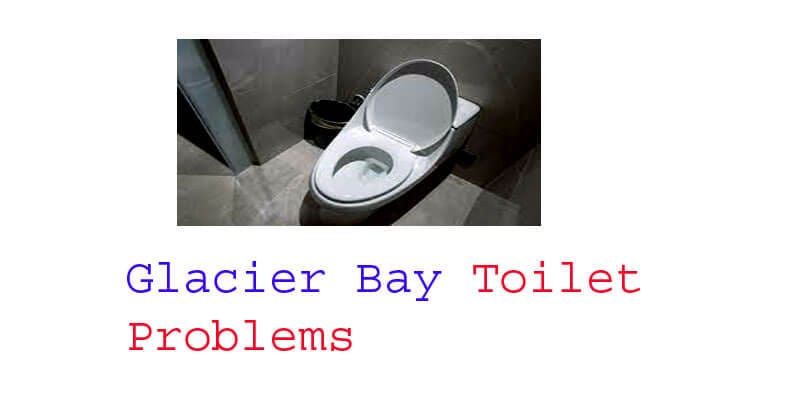Glacier Bay toilets frequently experience problems, such as clogs, leaks, and flush issues. These issues can often be fixed with minor repairs or adjustments, but in some cases, they may require replacement parts or professional assistance.
By understanding these common toilet problems and how to address them, you can keep your Glacier Bay toilet functioning smoothly and avoid the frustration and inconvenience of a malfunctioning toilet. In this article, we will explore some of the most common glacier bay toilet problems and offer solutions to help you troubleshoot and solve these issues.
Whether you are a homeowner or a professional plumber, this guide will provide you with the information you need to keep your Glacier Bay toilet running smoothly for years to come.

Identifying The Problem: How To Determine What’s Wrong With Your Toilet
Glacier Bay Toilet Problems: Identifying The Problem
Dealing with a problematic toilet can be both frustrating and embarrassing if it happens in front of guests. From flushing issues to leaks, identifying the problem is the first step toward fixing it. In this post, we’ll discuss the most common Glacier Bay toilet problems and how to determine what’s wrong with your toilet.
Checking For Leaks: The Signs And Symptoms Of A Faulty Flapper Valve
One of the most common toilet problems is a leak, which can be caused by a faulty flapper valve. Here are some signs and symptoms to look out for:
- Water runs in the bowl even when the toilet isn’t being used.
- A hissing or trickling sound coming from the toilet tank.
- A noticeable drop in the water level in the tank.
To check if the flapper valve is faulty, add a few drops of food coloring to the tank and wait for around 15 minutes. If the water in the bowl changes color, the flapper valve isn’t sealing correctly, and water is escaping into the bowl.
Understanding Drainage Problems: What To Do If Your Toilet Won’t Flush Completely
If your Glacier Bay toilet won’t flush completely, it’s usually due to a drainage problem. Here’s what to do:
- Use a plunger to try to clear the blockage. If this doesn’t work, you can use a drain auger.
- If the blockage is still present after using a plunger and drain auger, try using a toilet snake to break up the clog.
Investigating Fill Valve Issues: How To Determine If Your Tank Is Filling Correctly
A fill valve problem can cause your toilet tank to fill slowly, leading to weak flushes. Here’s what to do:
- Check that the water supply valve is fully open.
- Check the fill valve for any clogs or debris that might be obstructing the flow of water.
- If the problem is still present after checking the water supply valve and fill valve, replace the fill valve.
Addressing Tank Condensation: How To Fix A Sweating Toilet Tank
If you notice water droplets on the outside of your toilet tank, it could be due to tank condensation. Here are some steps to fix it:
- Check the temperature of the water in the tank. If it’s colder than the room, it can cause condensation. Try adjusting the water temperature.
- Install a tank insulator kit to prevent temperature differences between the tank and the room.
Other Problems To Watch Out For A Brief Overview Of Less Common Toilet Issues
While the above issues are the most common with glacier bay toilets, other problems can occur. Here’s a brief overview:
- Cracks in the porcelain bowl or tank can lead to leaks or even complete breakage. If there’s a crack, replace the toilet.
- Loose or broken bolts and other components can cause leaks and rocking. Tighten or replace any loose or broken components.
Identifying the problem with your Glacier Bay toilet is the first step toward fixing it. By checking for leaks and drainage problems, investigating fill valve issues, and addressing tank condensation, you can resolve most toilet problems. For less common issues, always call a professional plumber for assistance.
Tools And Techniques For Fixing Toilet Problems
Dealing with toilet problems can be frustrating, but understanding the tools and techniques to fix them can make the process much simpler. Here are some essential tips to help you fix your Glacier Bay toilet at home:
Flapper Valve Replacement: How To Replace A Faulty Flapper Valve And Stop Leaks
Flapper valves are responsible for regulating the water flow in your toilet bowl. When they become old or faulty, they can leak water, create constant noise, or even cause your toilet to flush on its own. Here’s what you need to do to replace a faulty flapper valve:
- Turn off the water supply to your toilet.
- Empty the toilet tank of water.
- Detach the old flapper valve.
- Install the new flapper valve, following the instructions that come with it.
- Turn on the water supply to test it.
Clearing Clogs With A Plunger: Step-By-Step Instructions For Using A Plunger Correctly
Glacier Bay toilet problems: tools and techniques for fixing toilet problems
Clogs are a common issue that can be resolved by using a plunger. Here are some tips for proper plunging techniques:
- Place the plunger over the toilet drain and cover it with water.
- Push the plunger in and out, creating a vacuum to loosen the blockage.
- Repeat until the water drains freely.
Augers And Other Drain Cleaning Techniques: When To Use Alternate Methods
If you have a stubborn clog, an auger or other drain-cleaning methods may be necessary. Here’s what you need to know:
- Always start with the least invasive method first, such as a plunger.
- If a plunger doesn’t work, try using an auger to dislodge the clog.
- If that doesn’t work, consider calling a plumber for more advanced techniques.
Identifying The Fill Valve: How To Figure Out What Type Of Fill Valve Your Toilet Has
Fill valves are responsible for refilling the tank after each flush. If you need to replace or alter your fill valve, you’ll need to know what type of fill valve your toilet has. Here’s how to identify it:
- Look for the valve’s color and shape.
- Check your owner’s manual or search online if necessary.
Adjusting The Fill Valve: How To Alter Fill Valve Settings For Optimal Performance
Adjusting the fill valves can help you save water and improve your toilet’s performance. Here’s what you need to do:
- Locate the fill valve adjustment screw.
- Turn the screw clockwise to decrease the water level or counterclockwise to increase it.
- Flush your toilet and check the water level to ensure optimal performance.
By following these tools and techniques for fixing your Glacier Bay toilet problems, you can save money and avoid the inconvenience of calling a plumber. Remember to follow instructions carefully and stay safe while working with toilets.
Preventing Toilet Problems Before They Happen
Glacier Bay toilets are known for their durability and performance, but like any other plumbing fixture, they are not immune to problems. The good news is that most toilet issues can be prevented before they happen. We’ll cover some tips on how to keep your Glacier Bay toilet in excellent working condition for years to come.
Regular Cleaning Tips: How To Keep Your Toilet Clean And Water Flowing Freely
To ensure that your glacier bay toilet performs at its best, it’s essential to clean it regularly. Here are some cleaning tips that can help you maintain a hygienic and fully functional toilet:
- Use a brush and a cleaner specifically designed for toilets to scrub away any buildup around the bowl and rim. Avoid using harsh chemicals that can damage the porcelain or the pipes.
- Check the tank and bowl for any leaks or cracks. Even small leaks can lead to significant water waste over time, so it’s crucial to fix them as soon as possible.
- Make sure to flush only human waste and toilet paper down the toilet. Avoid flushing anything else, such as wet wipes, feminine hygiene products, or paper towels, which can clog the pipes and cause sewer backups.
- Test the water pressure and the flush mechanism periodically to ensure that everything is working correctly. If you notice any issues, such as a weak flush or slow water flow, contact a plumber to diagnose and fix the problem.
Upgrades And Modifications: Which Ones Are Worth The Investment To Avoid Problems Down The Line?
Apart from regular cleaning and maintenance, there are some upgrades and modifications that you can make to your Glacier Bay toilet to prevent problems and prolong its lifespan. Here are some ideas:
- Replace the flapper, the fill valve, and any other worn-out parts that can cause leaks or water waste. Upgrading to high-efficiency parts can save you money on water bills in the long run.
- Install a bidet attachment or a smart toilet seat that can reduce the need for toilet paper and improve hygiene.
- Consider installing a water softener or a whole-house filtration system if you live in an area with hard water or poor water quality. Hard water can cause mineral buildup in the toilet and the pipes, leading to clogs and corrosion.
Proper Usage Instructions: How To Educate Your Household On Best Practices And Preventative Measures
Finally, one of the best ways to prevent toilet problems is to educate your household members on how to use the toilet correctly and to adopt preventive measures. Here are some tips:
- Teach everyone in your household to flush the toilet only when necessary and to use the appropriate amount of toilet paper. Overusing toilet paper can cause clogs and strain the plumbing system.
- Put up a sign or a reminder not to flush anything other than human waste and toilet paper down the toilet. You can also provide a small waste bin in the bathroom for other items.
- Show your family members how to perform basic maintenance tasks, such as cleaning the toilet, checking for leaks, and adjusting the water level. Involve them in the process and make it a fun and educational activity.
- Consider posting a list of do’s and don’ts near the toilet to remind everyone of the best practices and prevent common mistakes.
By following these tips and adopting good habits, you can ensure that your glacier bay toilet runs smoothly and efficiently for years to come. Remember, prevention is always better than cure when it comes to plumbing problems, so make sure to take care of your toilet regularly!
When To Call In A Professional: Knowing Your Limits
When it comes to common household issues, a malfunctioning toilet is near the top of the list. Whether it’s constantly running, refusing to flush properly, or simply making strange noises, a faulty toilet can be a major inconvenience. While some of these problems can be resolved with a simple DIY fix, others require the expertise of a professional plumber.
In this post, we’ll take a closer look at Glacier Bay toilet problems and explore when it’s best to seek out professional help.
Safety Considerations: When It’s Best To Leave Repairs To The Pros
While it may be tempting to try to tackle plumbing problems on your own, it’s important to keep safety in mind. Here are a few scenarios where it’s best to call in a professional:
- If you notice water pooling around the base of your toilet, there may be an issue with the wax seal or flange. This can cause water to seep into your flooring or subfloor, leading to extensive damage if left untreated. A plumber can quickly and safely diagnose the issue and replace the damaged components.
- If your toilet is overflowing or won’t stop running, this could indicate a malfunctioning fill valve or float switch. These components control how much water enters the tank and when the toilet stops filling. Attempting to repair these yourself can lead to water damage and potentially hazardous situations.
- If you notice a foul odor or suspicious sounds when using your toilet, this could indicate a problem with your sewer line, which can be a potential health hazard. A professional plumber can assess the situation and provide safe and effective solutions.
When Diy Corrections Just Aren’t Enough: How To Know When It’s Time To Consult A Plumber
While it’s always a good idea to attempt simple fixes yourself, there are certain problems that require the skill and experience of a professional plumber. Here are a few signs that it may be time to call in the experts:
- If you’ve attempted several DIY fixes and the problem persists, it’s time to bring in a pro. Continuing to tinker with your toilet can do more harm than good and may even make the problem worse.
- If you’re dealing with recurring issues, it’s also time to call in a professional. While you may be able to temporarily fix the issue, there could be an underlying problem that only a plumber can diagnose and repair permanently.
- If you come across a problem that you’re simply not comfortable handling, don’t hesitate to call in a professional. Plumbing can be a tricky business, and it’s always better to be safe than sorry.
Finding The Right Professional For Your Needs: Tips For Choosing The Best Plumber For Your Job
If you’ve determined that you need to call in a professional plumber, the next step is finding the right one for your needs. Here are a few tips for choosing the best plumber for your job:
- Do your research. Look for plumbers in your area with good reviews and a proven track record.
- Don’t be afraid to ask for referrals from friends or family members who have had work done in the past.
- Check for licensing and insurance. A reputable plumber will be properly licensed and insured, which protects both you and the plumber in case of any accidents or damage.
- Get quotes from multiple plumbers and compare their rates and services.
- Finally, trust your instincts. If you don’t feel comfortable with a particular plumber or their approach, it’s okay to keep looking until you find the right fit.
Frequently Asked Questions About Glacier Bay Toilet Problems
Why Is My Glacier Bay Toilet Not Flushing Correctly?
There are several reasons why your toilet might not be flushing, such as a clogged toilet or issues with the tank components.
How Can I Fix My Glacier Bay Toilet That Keeps Running?
If your toilet keeps running, try adjusting the flapper or float valve. If that doesn’t work, you may need to replace these components.
What Kind Of Maintenance Does A Glacier Bay Toilet Require?
To keep your glacier bay toilet in good condition, you should regularly clean it, check the tank components, and perform any necessary repairs.
Can I Install A Glacier Bay Toilet On My Own?
Yes, you can install a glacier bay toilet on your own if you have some experience with plumbing and the proper tools.
How Do I Choose The Right Glacier Bay Toilet For My Bathroom?
Consider factors such as the toilet’s dimensions, flushing power, and water usage when choosing a glacier bay toilet for your bathroom.
Other Troubleshooting Guide
GE WASHER STUCK ON SENSING: TROUBLESHOOTING GUIDE
Conclusion
The glacier bay toilet may be a popular choice due to its affordability and efficiency, but it can also present problems for homeowners. The most common issues include a weak or broken flush, continuous running, and slow refilling. While some of these problems can easily be fixed with simple troubleshooting steps, others may require the replacement of certain parts or seeking professional help.
It is important for homeowners to address these problems immediately to prevent damage to the toilet and avoid wasting water. Despite the issues, the glacier bay toilet remains a great option for those looking for an affordable and environmentally friendly solution for their bathroom needs.
With proper maintenance and repair, homeowners can continue to enjoy the benefits of their glacier bay toilets for years to come.





